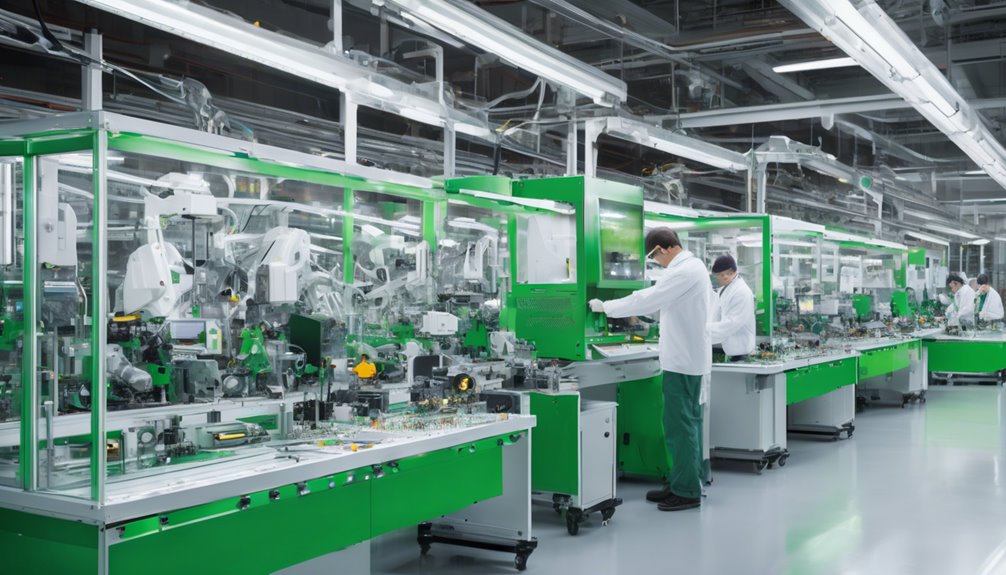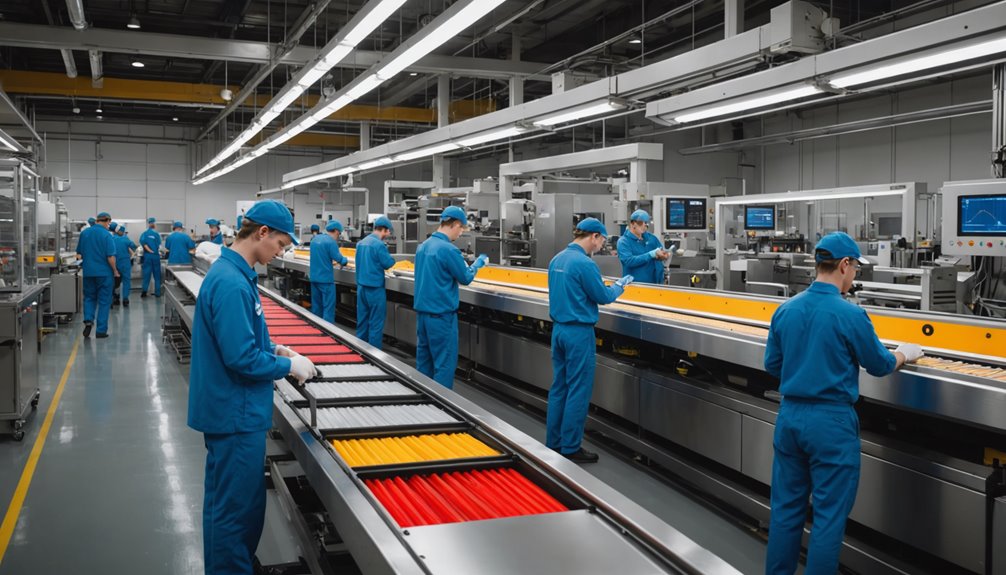First Pass Yield (FPY) is a key metric in manufacturing that measures how effectively your production process generates defect-free products. Understanding FPY can help you pinpoint inefficiencies and enhance product quality. As you explore this concept, you'll uncover its significance in reducing costs and improving customer satisfaction. But what factors play a role in achieving a high FPY, and how can you address them?
Defining First Pass Yield

First Pass Yield (FPY) is a crucial metric in manufacturing that measures the percentage of products produced correctly without any rework or defects on the first attempt.
You can calculate FPY by dividing the number of good units by the total units produced during a given period, then multiplying by 100 to get a percentage. A higher FPY indicates a more efficient manufacturing process, reducing time and costs associated with rework.
Understanding FPY helps you identify areas for improvement and streamline production. It's vital for maintaining quality standards and customer satisfaction.
The Importance of First Pass Yield in Manufacturing
Understanding First Pass Yield isn't just about tracking a number; it's about recognizing its impact on your entire manufacturing process.
High First Pass Yield means fewer defects and less rework, which saves time and resources. When you focus on improving this metric, you're enhancing product quality and customer satisfaction.
It also fosters a culture of continuous improvement among your team, encouraging proactive problem-solving and innovation. By prioritizing First Pass Yield, you can streamline operations, reduce waste, and ultimately boost profitability. Additionally, improving First Pass Yield can significantly lower the Cost of Poor Quality, which directly impacts your bottom line.
How to Calculate First Pass Yield

Calculating First Pass Yield (FPY) is straightforward and essential for assessing your manufacturing efficiency. To determine FPY, you'll need just two key figures: the number of units produced and the number of units that pass inspection without any rework.
First, count the total number of finished products. Then, identify how many of those met quality standards on the first attempt.
Next, use the formula: FPY = (Number of Good Units / Total Units Produced) × 100.
This will give you a percentage that reflects how well your processes are performing.
Regularly calculating FPY helps you spot trends, identify areas for improvement, and ultimately enhance your production effectiveness. Keep an eye on this metric to drive continuous improvement in your operations.
Factors Affecting First Pass Yield
While assessing your First Pass Yield (FPY), you'll encounter several factors that can significantly impact your results.
One key factor is process variation; even minor inconsistencies can lead to defects.
Equipment performance also plays a crucial role—if machines aren't calibrated or maintained properly, output quality may suffer.
Additionally, workforce skills are vital; well-trained employees tend to produce higher quality work, reducing errors.
Material quality shouldn't be overlooked; using subpar materials can lead to increased defects.
Lastly, communication within teams can affect FPY; clear instructions and feedback loops help minimize misunderstandings. Furthermore, implementing DMAIC methodology can provide a structured approach to identify and eliminate defects, ultimately improving FPY.
Benefits of Improving First Pass Yield

Improving your First Pass Yield (FPY) can lead to significant advantages for your production processes. Higher FPY means fewer defects, which directly saves you time and resources.
You'll notice reduced rework and scrap rates, allowing your team to focus on productivity rather than fixing mistakes. This efficiency not only boosts morale but also enhances your overall operational effectiveness.
Additionally, a strong FPY can improve customer satisfaction, as you'll deliver higher quality products faster. This reliability can strengthen your brand's reputation in the market. Furthermore, implementing Six Sigma methodologies can provide a structured approach to identify and eliminate defects, further enhancing your FPY.
Ultimately, investing in FPY improvements can lead to lower costs and increased profitability, giving you a competitive edge. Embracing these benefits can transform how you operate and achieve your business goals.
Strategies for Enhancing First Pass Yield
Enhancing your First Pass Yield (FPY) starts with a thorough analysis of your current processes. Identify bottlenecks and areas where defects frequently occur.
Once you've pinpointed these issues, engage your team to brainstorm solutions. Implement standard operating procedures (SOPs) to ensure consistency and minimize variation in production.
Training your workforce is crucial; they need to understand quality standards and the importance of FPY. Additionally, invest in reliable equipment and technology to reduce errors.
Regularly review and refine your processes based on data and feedback. Finally, foster a culture of accountability where everyone takes ownership of quality. By utilizing statistical analysis tools, you can effectively evaluate data and measure performance metrics that directly impact FPY.
Common Challenges in Achieving High FPY

Achieving a high First Pass Yield (FPY) presents several challenges that can hinder your efforts. One major hurdle is inconsistent processes; if your procedures vary from one production run to another, it's tough to maintain quality.
Equipment reliability also plays a vital role; frequent breakdowns can lead to increased defects. Additionally, inadequate training for your team can result in errors that affect FPY.
Communication gaps between departments can further complicate matters, as misaligned goals and expectations often lead to mistakes. Finally, lack of data analysis can prevent you from identifying root causes of defects, making it difficult to implement effective solutions.
FPY vs. Other Quality Metrics
While First Pass Yield (FPY) focuses on the percentage of products manufactured correctly without rework, it's essential to compare it with other quality metrics to get a complete picture of your production process.
Metrics like Defect Rate and Cost of Poor Quality can provide insights into areas that FPY might overlook. For instance, a high FPY mightn't reflect overall quality if defects aren't tracked properly.
You should also consider Overall Equipment Effectiveness (OEE), which assesses the efficiency of your manufacturing process.
Real-World Examples of First Pass Yield Implementation

To truly grasp the impact of First Pass Yield (FPY) in production environments, examining real-world implementations can be enlightening.
For instance, in the automotive industry, a manufacturer improved FPY by streamlining its assembly line. By identifying and addressing bottlenecks, they reduced defects and increased output efficiency.
Similarly, a tech company implemented FPY metrics in its electronics production, allowing teams to pinpoint quality issues in real-time. This proactive approach led to a 20% increase in FPY within six months.
In pharmaceuticals, a firm utilized FPY data to refine its packaging processes, resulting in higher compliance rates.
These examples show how applying FPY principles can drive significant improvements across various sectors, enhancing overall productivity and quality.
Future Trends in First Pass Yield Measurement
As industries continue to harness the benefits of First Pass Yield, emerging trends are shaping how organizations measure and enhance this critical metric.
You'll notice an increasing reliance on automation and AI technologies to track FPY in real-time. This shift allows for quicker adjustments and more accurate data analysis.
Additionally, the integration of advanced analytics will enable you to pinpoint specific inefficiencies and target areas for improvement.
Organizations are also prioritizing employee training, fostering a culture of quality that enhances FPY.
Sustainability is becoming a key focus, with firms looking to reduce waste and improve yield through eco-friendly practices.
Conclusion
In conclusion, understanding and improving First Pass Yield is vital for enhancing your manufacturing processes. By focusing on FPY, you can boost efficiency, reduce costs, and ultimately increase customer satisfaction. Remember, tackling the challenges that come with achieving high FPY will lead to significant long-term benefits. So, prioritize FPY in your operations, and you'll likely see a positive impact on product quality and overall performance in your manufacturing efforts.

